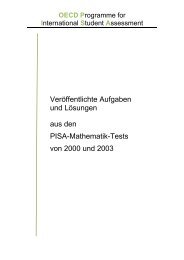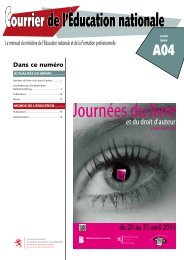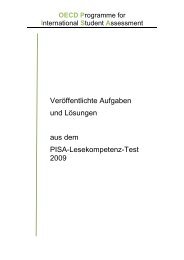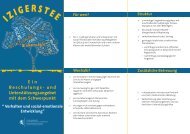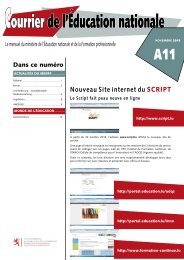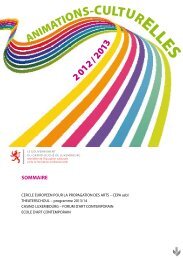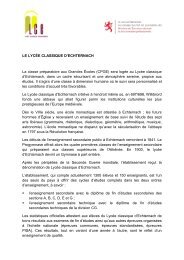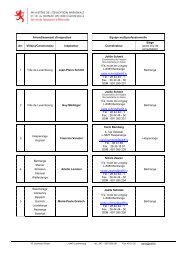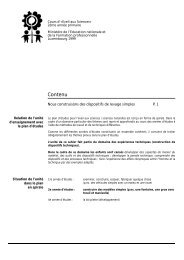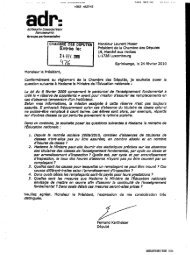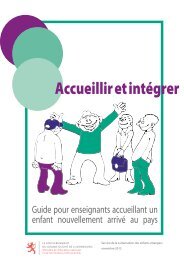Intermediate assessment report
Intermediate assessment report
Intermediate assessment report
Create successful ePaper yourself
Turn your PDF publications into a flip-book with our unique Google optimized e-Paper software.
ELEMENTARY SCHOOL<br />
Cycle 2<br />
<strong>Intermediate</strong><br />
<strong>assessment</strong> <strong>report</strong><br />
development of competencies
Dear parents,<br />
This intermediate <strong>assessment</strong> <strong>report</strong> allows you to follow the development of your child’s competencies<br />
throughout the 6 terms of one learning cycle.<br />
At the end of each term, you are invited to attend an individual meeting with your child’s teacher.<br />
For each subject, the teacher will give you feed-back on how your child’s performance rates are,<br />
in relation to the standards that have to be reached by the end of the learning cycle, and with<br />
regard to the expectations in an advanced level of German language and mathematics. Beforehand,<br />
the <strong>report</strong> will have been examined and discussed with your child.<br />
The numbers shown in the grid correspond to the different school terms. For example, number<br />
2 indicates where your child’s performance lies at the end of the second term of the cycle. The<br />
grid is gradually completed at the end of each term, thus enabling you to follow your child’s progress<br />
over time, always in relation to the standards defi ned for the end of the cycle.<br />
A circle below a box means that your child has not progressed since the previous term.<br />
Example: The grid shown below could correspond to following statements:<br />
The pupil is able to:<br />
identify and name a square,<br />
a triangle, a rectangle and a circle<br />
At the end of the fi rst term, the pupil is able to identify and name the circle and the<br />
triangle, but often confuses square and rectangle.<br />
At the end of the second term, the pupil is able to identify simple surfaces correctly, but<br />
only in situations previously practiced.<br />
At the end of the third term, the pupil demonstrates that he/she meets the defi ned expectancies<br />
of the end of the learning cycle, i.e. is able to identify and name simple surfaces<br />
regularly without help in situations that are familiar but have not been practised.<br />
During the fourth term, the pupil has not progressed in this competency.<br />
At the end of the fi fth term, the pupil is able to distinguish a square from a rectangle in<br />
most exercises, by correctly describing the properties of the respective fi gures.<br />
Example:<br />
Foundation level<br />
<br />
<br />
<br />
<br />
<br />
<br />
<br />
<br />
<br />
1 2 3 5<br />
The <strong>assessment</strong> <strong>report</strong> also provides information about your child’s attitudes and behaviour,<br />
not in relation to a specifi c subject, but concerning personal developments throughout his/her<br />
schooling. These are cross-disciplinary competencies. They are assessed by the use of the letters<br />
A, B, C and D.<br />
A = in need of improvement B = satisfactory C = good D = excellent<br />
The pupil:<br />
cooperates and collaborates with other pupils<br />
L’élève est capable<br />
describe the properties of<br />
simple surfaces<br />
Term.1 Term. 2 Term. 3 Term. 4 Term. 5 Term. 6<br />
A B C C D C
The pupil:<br />
cooperates and collaborates with other pupils<br />
acts in a civil and responsible manner<br />
abides the rules for living in a community<br />
works independently<br />
takes initiatives<br />
participates actively in class<br />
complies with deadlines<br />
presents work neatly<br />
takes care of his/her handwriting<br />
Cross-curricular competencies<br />
Term.1 Term. 2 Term. 3 Term. 4 Term. 5 Term. 6
Speaking<br />
Listening<br />
Writing<br />
Reading<br />
German language<br />
Basic Standard Target standard<br />
The pupil can<br />
express him-/herself using words and<br />
basic phrases<br />
provide simple information about him-/<br />
herself and his/her family and a circle<br />
of friends<br />
interact in a simple way on familiar<br />
topics<br />
express him-/herself in simple and<br />
short sentences in front of other<br />
people, using sentences previously<br />
studied in class<br />
The pupil can<br />
understand and subsequently follow<br />
simple instructions<br />
identify the essential ideas of a message<br />
bring out and reconstruct isolated<br />
items of information from a simple<br />
listening document<br />
follow the thread of a conversation in<br />
which he/she is involved<br />
The pupil can:<br />
write clear short texts by himself<br />
use vocabulary learned in class in his/<br />
her work<br />
spell the most frequently used words<br />
correctly<br />
comply with elementary rules of syntax<br />
The pupil can<br />
read a text aloud<br />
understand a text by identifying the<br />
principal elements<br />
formulate hypotheses from reading the<br />
title or looking at the illustrations<br />
read a book written in simple language<br />
and containing images illustrating the<br />
text<br />
<br />
<br />
<br />
<br />
<br />
<br />
<br />
<br />
<br />
<br />
<br />
<br />
<br />
<br />
<br />
<br />
The pupil can<br />
express him-/herself fl uently<br />
provide information on a subject of<br />
interest to him/her, express feelings and<br />
personal ideas<br />
interact in a conversation in a fl owing and<br />
diverse manner.<br />
present a story, an experience or a role<br />
in an original and creative way in front of<br />
an audience<br />
The pupil can<br />
understand information and apply it in an<br />
autonomous way<br />
understand implicit messages, and assess<br />
and appreciate them<br />
understand the overall content of a listening<br />
document<br />
follow and participate in a conversation<br />
involving several people<br />
The pupil can:<br />
write short stories by himself<br />
use varied vocabulary to enrich his/her<br />
work<br />
work on a text using reference tools<br />
comply with the rules of syntax and use<br />
connectors<br />
The pupil can<br />
read aloud clearly in an expressive way<br />
understand and examine the content and<br />
meaning of a text<br />
check various hypotheses by using the<br />
text<br />
read a book
Speaking<br />
Listening<br />
Speaking<br />
Listening<br />
Basic standard<br />
The pupil can :<br />
articulate in an understandable way<br />
French language<br />
participate in very simple, structured conversation organised in a class setting<br />
recite short texts from memory<br />
The pupil can:<br />
answer «who», «where» and «why» questions<br />
demonstrate his/her comprehension of a text through drawing and conversation<br />
carry out productive and creative tasks in relation to a text<br />
Basic standard:<br />
The pupil can:<br />
discuss familiar subjects in class<br />
The pupil can:<br />
Luxembourgish language<br />
recount briefl y (relate) a story (fi ction) or a personal experience<br />
memorise and recite a nursery rhyme<br />
understand an instruction containing at least two actions described in familiar terms<br />
Understand the overall meaning and principal ideas of the other person in a conversation<br />
about familiar subjects<br />
identify the various talkers in an audio text
Space and shapes<br />
Numbers and operations<br />
Sizes and measurement<br />
Problem-solving<br />
Mathematics<br />
Standard level Target standard<br />
The pupil can:<br />
identify dentify and name a square, a triangle, a<br />
rectangle and a circle<br />
represent surfaces on squared paper<br />
recognise and continue repeating<br />
patterns in mosaics and geometric<br />
motifs<br />
The pupil can :<br />
Associate numbers and representarepresentations of numbers between 0 and 100<br />
Solve simple additions and subtractions<br />
bridging 10<br />
understand the connection between<br />
addition and subtraction<br />
The pupil can:<br />
identify and name units of<br />
measurement in everyday situations<br />
(litre, kilo, hectare, metre, euro)<br />
measure using the standard units of<br />
measurement<br />
The pupil can:<br />
identify the relevant information in the<br />
wording of a problem<br />
anticipate results<br />
solve single-stage problems<br />
formulate problems on the basis of<br />
arithmetical operations and illustrations<br />
communicate the result verbally, in wriwriting or by means of an illustration<br />
<br />
<br />
<br />
<br />
<br />
<br />
<br />
<br />
<br />
<br />
<br />
<br />
<br />
The pupil can:<br />
describe the properties of simple surfaces<br />
construct combined surfaces<br />
continue complex geometric motifs and<br />
create his/her own motifs<br />
The pupil can<br />
compare and allocate numbers between<br />
0 and 100 and estimate quantities<br />
mentally carry out operations of addition<br />
and subtraction between 0 and 100<br />
use the properties of addition and subsubtraction in order to calculate effectively<br />
The pupilcan<br />
round up/down and (make correct as- as-<br />
sumptions) make estimates in exercises<br />
concerning measurements<br />
compare and classify using the standard<br />
units of measurement<br />
The pupil ican<br />
make use of relations between the pieces<br />
of information contained in problems<br />
check the result of a problem and justify it<br />
solve multiple-stage problems<br />
devise problems him-/herself<br />
represent, communicate and justify the<br />
result and the process verbally and in<br />
writing
Arts<br />
Music<br />
Basic standard<br />
The pupil can:<br />
Basic standard<br />
Basic standard<br />
Introduction to the sciences<br />
formulate a simple research question in relation to the studied subject<br />
carry out simple observations systematically<br />
analyse and comment on observations<br />
present the consequences of his/her experiment in the form of drawings, tables<br />
or simple sentences<br />
Self-expression through movement, psycho-motor development,<br />
sport and health<br />
The pupil can:<br />
use his/her coordination abilities and skills: spatial orientation, balance, response<br />
time, rhythm, kinaesthetic differentiation<br />
Produce a sustained effort<br />
Actively participate in a game, complying with the rules and applying appropriate<br />
strategies<br />
Use fair-play, whilst taking into consideration him-/herself and other participants<br />
The pupil can.<br />
Introduction to aesthetics, creation and culture<br />
properly use artistic techniques developed in class<br />
express him-/herself by means of personal artistic creations<br />
analyse and comment on his/her own artistic productions and those of others<br />
The pupil can:<br />
sing a number of songs belonging to the class’s repertoire<br />
reproduce and produce simple rhythms<br />
use simple formulations to express his/her impressions upon hearing sound extracts
Moral and social<br />
education<br />
Religious and moral instrucinstruction Basic standard<br />
The pupil can:<br />
Living in community and values<br />
describe various types of behaviour and express him-/herself in relation to the<br />
feelings they provoke<br />
Distinguish symbols and understand that they may refl ect different traditions,<br />
backgrounds and ways of living<br />
put himself in another person’s position and accept a different opinion<br />
The pupil can:<br />
understand and apply the symbolic language of biblical stories and tales<br />
understand the connection between situations in everyday (personal) life and<br />
religious stories and express it verbally, using physical expression, or in creative<br />
terms<br />
associate religious celebrations with relevant symbols and explain these
Date Observations by the teacher:



